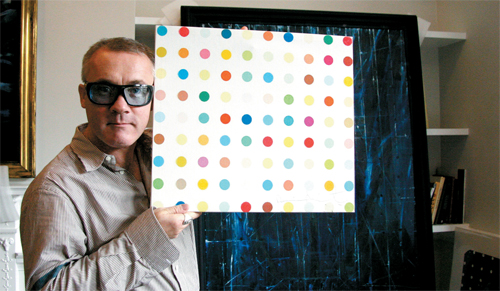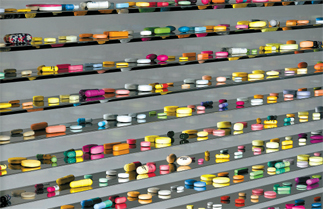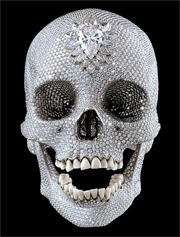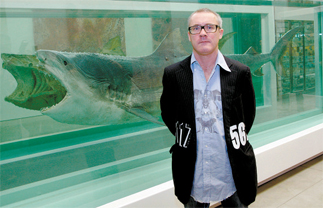Rough diamond sees hope in dead sharks and skulls

Damien Hirst holds up a dot painting that he purchased on e-Bay, a fabrication of his own work. By Kwon Geun-young
The British artist Damien Hirst, 43, is known as an enfant terrible, Mr. Death, the devil’s child and a cult sculptor in modern art.
His provocative works include a skull covered in 8,601 diamonds worth 91.8 billion won ($8.78 million), a shark submersed in formaldehyde and the rotting head of a cow covered in flies.
The art magazine ArtReview ranked him 11th in 2006 among 100 world artists. Last year, he ranked sixth.
In March this year, his work, including “Spin Painting” and “Dot Painting,” were exhibited in Busan as part of the nationwide Seoul Art Fair.
Until the end of this month, Interart, a gallery in Cheongdam-dong, southern Seoul, will be exhibiting a painting by Hirst of a skull titled “The Fate of Man,” and a painting of a butterfly titled, “The Soul on Jacob’s Ladder.” The skull is thought to represent a man facing death and the butterfly symbolizes a soul dancing between life and death. The title of the exhibition is “New Religion.”

Hirst’s “Lullaby Spring,” which sold in London to an anonymous collector, is a three-meter wide steel cabinet containing 6,136 handcrafted and individually painted pills. [YONHAP]

Hirst encrusted a skull with thousands of diamonds and called the work “For the Love of God.” [JoongAng Ilbo]
The British artist recently met with the JoongAng Ilbo at his office in London.
His office is decorated not only with his own work but with that of other artists, too. His work Spin Painting, where colored paint is placed on a round canvas and spun, sits on the front desk to his office.
The work of Michael Joo, a Korean-American artist, sits proudly in the reception area. On one wall in his office hangs a blue painting by the British artist Francis Bacon and on the other end is a painting of a skull in darker shade of blue.
On his desk stands a work by American artist Jeff Koon, a balloon figure of the Disney cartoon character, Dumbo.
Hirst said he hopes people would not misunderstand him or his provocative art. His work deals with death, a subject that plays on everyone’s minds, he said, but he also wants people to see the hope that he instills in his art.
The artist said he sees life as harsh, but he wasn’t trying to get people’s attention through shock therapy or by breaking taboos.
Hirst said aging means that you are getting closer to death, and he hates both aging and death. He deals with these two subjects, he said, because they are inspirational.

Hirst poses in front of “Death Explained,” a tiger shark cut in half, during an exhibition in central London in June 2007. [REUTERS]
Although he doesn’t believe in God, Hirst said he understands the existence of taboos. Through his work, he said he tries to seek liberation among ideas and images that society deems forbidden or unmentionable, though he added that he tries not to go too far.
Really? But what about the sharks, the dead cows and the skull? Hirst admitted he could not use a human body in his work that would be one taboo too many so he settles for dead animals and bones.
The artist’s personal favorites are the fly painting series, the shark and the diamond-covered skull, which is called “For the Love of God.”
He said he especially loves the shark because it was such an unusual concept. He said the original idea was to paint a shark. But then he changed his mind and used a real one. Since the shark work, Hirst said, the course of his career has taken a major turn. He gained confidence that he could do anything, and, like the scientist who created Frankenstein, Hirst said he was scared of the new terrain his art could take him.
Hirst said he has been involved in art since he was 5 years old. He drew a lot of the time because his mother was always busy.
Art is to understand the world by reorganizing the world, Hirst said. When he was young he said he used to see a tree on his way to school every day, but one day the tree was felled and Hirst was devastated by the loss. “That’s art,” he said.
By Hirst’s definition, art is something that starts off average and rather bland but is transformed into something wholly new when viewed from an entirely different point of perspective.
Hirst is also well known as an art collector. Early last year, he exhibited 60 art pieces at the Serpentine Gallery in London. He owns art by Francis Bacon, Jeff Koon, Andy Warhol, among others.
He said it is amazing to see fine art pieces at his own home instead of in museums, and the proximity of such art could help him create better work himself, he added.
He has no set rules when it comes to collecting, he said. Anything that catches his eye is worthy of a place.
The artist said he tries to avoid people who buy his work at a high price. He’s not at all interested in people who buy his work and sell it later. Instead, Hirst said he advises people to keep the art they purchase, and, in his experience, he said people who deal in art to make money usually buy art that is not that valuable.
Few artists are successful and for that reason investing in art is dangerous, he said, adding that there are easier ways of making money than buying and selling paintings.
Hirst was born in Bristol, England, in 1965 and grew up in the industrial city of Leeds. His father was a car salesman and left his family when the artist was 12.
While Hirst’s mother was a devoted Catholic, the young artist was into punk rock like The Sex Pistols.
He made his debut in the art world 20 years ago when he exhibited “Freeze,” in an abandoned warehouse when he was a student at Goldsmiths, University of London, in 1988.
His career blossomed when he met art collector Charles Saatchi, who helped groom young artists. In 1992, Hirst participated in the “Young British Artists” exhibition at Saatchi’s gallery. He went on to win the Turner Prize in 1995, a much-vaunted art award in the United Kingdom.
By Kwon Geun-young JoongAng Ilbo [ojlee82@joongang.co.kr]










with the Korea JoongAng Daily
To write comments, please log in to one of the accounts.
Standards Board Policy (0/250자)